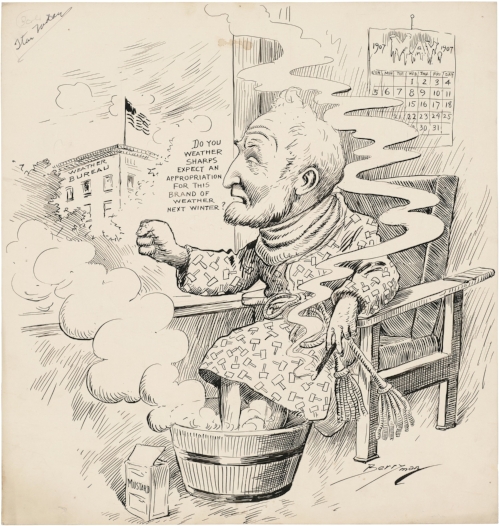Cannon Attacks the Weather Bureau, 1907
House Speaker Joseph Cannon threatens the funding for the US Weather Bureau after getting sick during an unusually cold May, 1907. Cartoon by Clifford Berryman, published in the Washington Evening Star, May 25, 1907, held by the US National Archives.
Why do weather forecasters get blamed for the weather? It’s a long-running trope, dating back at least to the early days of government weather service in the US, and probably farther. The story usually gets played for laughs in photograph captions and cartoons.
Here, one of the more notable political cartoonists in American history used the trope to poke fun at one of the nation’s most powerful political leaders.
Clifford Berryman (1869-1949) drew cartoons for the Washington Post and later the Washington Evening Star between 1891 and 1949. His 1902 picture of Theodore Roosevelt refusing to shoot a bear cub launched the Teddy Bear as a popular toy, and teddy bears became a recurring icon in Berryman’s work.
Washington suffered an unusually chilly May in 1907. Joseph Cannon, the powerful Speaker who ruled the House of Representatives and punished those who defied him, caught a cold. Berryman depicted Cannon clad in a gavel-print robe, feet steaming in a mustard bath. He rails at the Weather Bureau, threatening the Bureau’s funding for next year for producing "this brand of weather." Cannon may have been able to dominate the Government, but even his powers are limited by the weather, Berryman implied.
Uncle Sam asks the Weather Bureau for a respite from snow on January 31, 1918. Cartoonist Clifford Berryman's trademark teddy bear looks beleaguered too. Image published in Washington Evening Star, and now held by the National Archives.
Another Berryman cartoon played with meteorologists’ control over the weather eleven years later. During January, 1918, a long stretch of snow and ice had gripped Washington. Coal shipments nationwide had been disrupted when the railroads struggled to handle the increased traffic as the nation mobilized for World War I. Berryman depicted Uncle Sam digging out, a shovel in hand, asking the Weather Bureau to “Have a Heart!” as it predicts more snow and a cold wave.
Source of Images:
Berryman Political Cartoon Collection, 1896 - 1949; Record Group 46: Records of the US Senate, 1789-2015; US National Archives and Records Administration.







